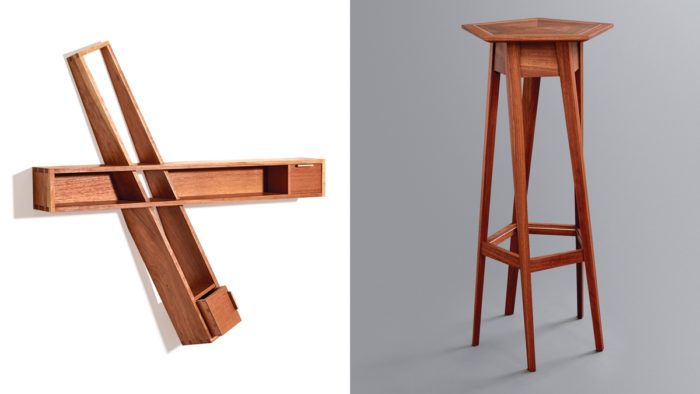Designer’s Notebook: Playing with angles
Design inspiration could strike at any time, so furniture maker Jamie Herman makes sure to keep a sketchbook handy to record his ideas while they're still warm.
Synopsis: Design inspiration could strike at any time, so Jamie Herman makes sure to keep a sketchbook handy so he can record his ideas while they’re still warm. From there, his design process moves to a place where he can see the piece in three dimensions, whether that’s through a CAD program or a model. As he refines the design, that’s where the magic sometimes happens.
The craft of furniture making is a constant push and pull between form and function. As woodworkers and designers, we make objects that are a balance of these two ideas, taking a familiar form like a chair and inserting it somewhere on the spectrum between pure sculpture and total practicality. Between these extremes an object can be both a joy to interact with and a joy to behold. We know these pieces when we see them, and there usually isn’t some big secret as to why they sing—they’re just well designed. Design is a skill that takes time to develop, just like learning to use a chisel or a saw. It takes repetition, practice, failure, and thought to improve. It’s a skill that is constantly evolving within each of us, and something we never really finish learning. My design process usually starts with a sketch.

My design process usually starts with a sketch. Sketching is a fantastic way to get an idea out of your head and to give it form. For me, sketches are more of a mental placeholder than anything else—I just want to have enough drawn so I can remember what I was thinking when the concept came to me. My best ideas almost never happen when I’ve been sitting down with my sketchbook actively trying to design furniture; instead, they usually come when I give my brain a little distance from the shop. When inspiration strikes, get that idea sketched! I don’t bother being overly analytical at this point; the important part is just getting the ideas out of my head and onto a page.
After I’ve refined my sketches a bit and have an idea that seems promising, I find a way to make it three-dimensional. It can be through a scale model or a full-sized mockup, or by modeling the design in a CAD program. However it’s done, you want to be able to look at your idea from every angle. Once you have a three-dimensional representation you can start to get critical. What are the most interesting views of the piece? Why? More importantly: What are the least interesting views? Why don’t they work?
I tend to use compound angles to add interest and three-dimensionality to my pieces. I like to use forms that interact with each other at complex angles to make my furniture more dynamic, and to add a sense of balance and motion. I always try to design my pieces as if they will be sitting in the middle of a room; I want to make sure my work invites exploration from every viewpoint. I’d say half of the reason for me using these tilted forms stems from my desire to make interesting furniture that I’ve never seen before. The other half is me trying to push myself technically, setting up complicated builds as challenges to test my skills.

Introducing angularity doesn’t make a piece inherently more difficult than square work. Every cut you make on a tablesaw is a balance of two angles, usually the right angle of the fence or sled and the right angle of the blade. It’s just as hard to get two perfect 90° angles as it is to set those cuts up to, say, 77° and 125°. The only big difference lies in the planning. This is easily the most important step in my build process. I use 3-D modeling software while I design so that I know exactly what I’m doing when I start making cuts. I want to know what every angle will be, what every dimension is, and how it’ll look when put together. There are lots of great programs that can accomplish this for you, from SketchUp to Fusion 360 to Solidworks. They take a lot of practice to master, but have become invaluable tools for me.
Construction-wise, working with a tilt often leads me down the road of complex veneering projects. I may be in the minority saying this, but I absolutely love veneering and the versatility it allows me as a designer. With solid wood, so much revolves around controlling wood movement that our techniques can sometimes dictate our designs instead of the other way around. I’m a firm believer that one should design first and let the build process develop accordingly.
Furniture making is often a slow and time-consuming process, so it’s worth it to make sure you’re happy with your design before you begin a big build. Try to think in three dimensions during the design process, and take the time to give your ideas some critical thought. Ask yourself not only what you like and don’t like, but also why you feel that way. Design is just as important to the making of a successful piece as technical precision. Design with purpose, explore, take risks, and challenge yourself to find what makes your own voice unique.
From Fine Woodworking #281
 |
|
 |
|
 |
Fine Woodworking Recommended Products

Compass

Sketchup Class

Circle Guide



























Log in or create an account to post a comment.
Sign up Log in